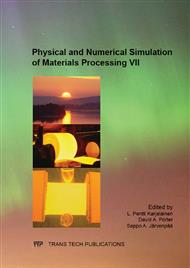p.538
p.544
p.551
p.556
p.562
p.570
p.578
p.584
p.590
The Effect of Stabilizers on the Grain Growth and Impact Toughness of 21%Cr Ferritic Stainless Steels High-Temperature Heat-Affected Zones
Abstract:
Grain growth during welding and the level of impact toughness in thermally simulated high-temperature heat-affected zones were determined for a series of AOD-level laboratory melted 21% chromium ferritic stainless steels. The effects of niobium and titanium stabilizing elements on microstructure were evaluated by optical and scanning electron microscopy. Overall, grain growth was only slightly affected by the stabilizing element ratio. On a weight percent basis, niobium was the most effective for restricting the grain growth in the heat-affected zone either alone or in the presence of a small amount of titanium. The predominantly niobium-stabilized heats also had the highest impact toughness in both air-cooled and water-quenched conditions, differences in transition temperatures being up to 55 °C. However, all the simulated heat-affected zones fit into a narrow ductile-to-brittle transition temperature band width of 30 °C, even including variations in heat input. This was attributed to intense grain boundary precipitation, which occurred even with a low heat input.
Info:
Periodical:
Pages:
562-569
Citation:
Online since:
July 2013
Authors:
Price:
Сopyright:
© 2013 Trans Tech Publications Ltd. All Rights Reserved
Share:
Citation:


